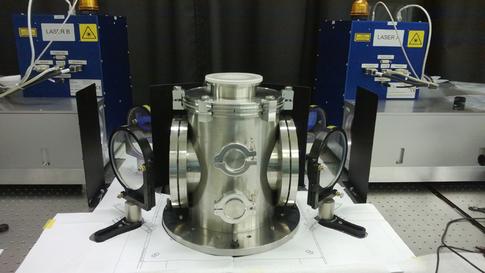XFEL: UK contributes a high-energy optical laser to HED instrument
UK contributes a high-energy optical laser to HED instrument
The Science and Technology Facilities Council (STFC) in the United Kingdom will contribute to the European XFEL an optical laser that will generate conditions similar to the interior of Earth-like exoplanets. The £8 million (approximately 11 million euro) development and construction of the laser will be funded by STFC and the Engineering and Physical Sciences Research Council, within a grant framework overseen by Professor Justin Wark at the University of Oxford.
The so-called DiPOLE laser will provide a very high repetition rate of ten pulses per second, with each pulse having an energy of 100 J (the same energy needed to lift a kilogram weight 10 metres high). This high average energy output was gained by a technology using diode-driven amplifiers that was devised by the STFC’s Central Laser Facility (CLF), with the diodes enabling the high pulse rate.
When a pulsed, medium-intensity optical laser hits a solid sample, a shock wave is generated that compresses matter to hundreds of thousands of atmospheres and generates very intense heat. In order to produce an energy-dense material that has similar characteristics to what is theorized to be in an Earth-like exoplanet’s interior, the DiPOLE laser’s intensity is much lower at the beginning of the pulse than at its end, which is expected to create the compression more slowly. This so-called “shockless” or “ramp” compression would result in comparatively low temperatures of a few thousand degrees at most at pressures one million to ten million times that of ambient conditions. The energy-dense samples, which last a few nanoseconds, can be examined with a single X-ray FEL pulse before they would decompress. The data from the X-ray FEL pulses will reveal information about the physical nature and chemistry of high energy density matter.
The laser will be manufactured, assembled, and tested in the UK by CLF and will then be shipped for the final assembly in Germany. It is part of the contributions by the Helmholtz International Beamline for Extreme Fields at the European XFEL (HIBEF) user consortium and will be installed at the High Energy Density Science (HED) instrument. The UK previously has provided funding for the Serial Femtosecond Crystallography (SFX) user consortium and has stated its intention to invest up to £30 million to become the European XFEL’s twelfth member state.
“We are delighted to be part of this ambitious endeavor”, says CLF Director Prof. John Collier. “The European XFEL project is at the frontier of X-ray science, and the CLF is at the frontier of laser & plasma science. DiPOLE showcases British laser technology at its best and, when installed on the European XFEL in 2017, will provide unprecedented opportunities for both the UK and international scientific community.”
“We thank STFC and CLF for their engagement in this development. The user community has stated the need for a high-energy laser for compression experiments a long time ago”, says European XFEL Scientific Director Thomas Tschentscher. “The contribution by CLF, whose researchers have decades of experience in laser design and building, makes it now possible to meet this demand.”
For more information, visit the CLF website.

